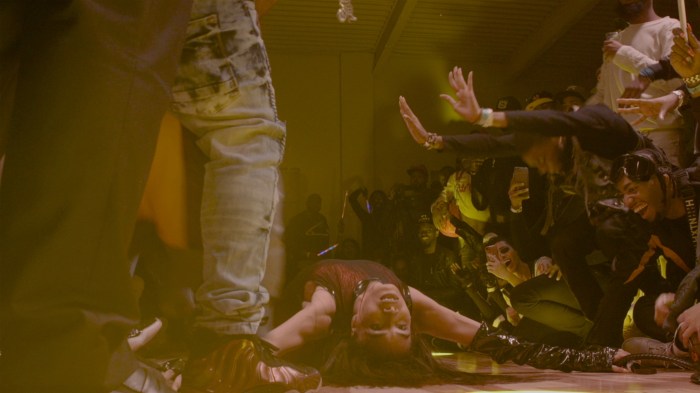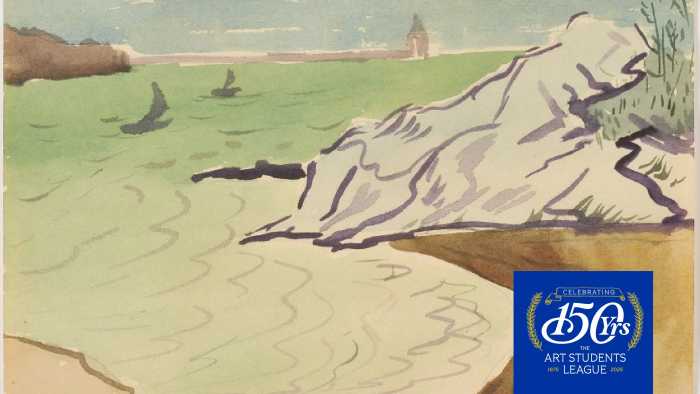Pekka Strang as Touko Laaksonen/ Tom of Finland in a scene in America with the lights fully up, from Dome Karukoski’s “Tom of Finland.” | JOSEF PERSSON/ KINO LORBER
Director Dome Karukoski’s classy, enthralling biopic of the gay pornographic illustrator known as Tom of Finland is more conventional that than one might expect given its subject. But this approach works in the film’s favor; viewers get to know and understand the man behind the homoerotic images.
Touko Laaksonen (Pekka Strang) is a war veteran coping with life in the repressive Finland of the 1950s. Living with his sister, Kaija (Jessica Grabowsky), and working for an ad agency, he finds himself a “hobby” drawing erotic illustrations of men, in and out of uniform. The images are perhaps a reaction to homosexuality being illegal at the time. Gay men, as the film shows, had to operate using sly codes of conduct to meet other men cruising at night or in bars. In Tom of Finland’s illustrations, the danger represented by authorities such as the police was exaggerated, with them made into fetishistic objects of desire. The taboo, voyeuristic qualities of his work were a response to the “look, don’t touch” aspect of queer life of the time.
When Kaija invites a young dancer, Veli (Lauri Tilkanen), to live with them as a boarder, Touko falls in love with him and the pair eventually begin a relationship that blossoms just as Touko’s artwork gains a fanbase overseas.
Dome Karukoski traces the blossoming of a shy homoerotic illustrator in post-war Scandinavia
“Tom of Finland” adroitly traces the artist’s life from his struggles in an underground society to his connection with a queer community and his success in America and elsewhere. At the film’s heart is a story about a shy man who wanted to fit it and was unaware of how much pleasure he gave millions of gay and closeted men around the world.
Director Karukoski met with Gay City News to talk about making “Tom of Finland.”
GARY M. KRAMER: How do you approach a biopic of Tom of Finland?
DOME KARUKOSKI: I spoke about that a lot with Pekka: that you can’t really act the image of Tom of Finland. We had descriptions from people who knew him. All the stories are from him as an old man, and so we were told he was a kind man and good at his job and in his art. He was humble in many ways. He became a Nordic god. Pekka said it well: you find the human being, the private person. You’re not acting Tom of Finland. You’re doing a film about a man who isn’t allowed to come out with his art or his passion. There you have the conflict: how does that change your behavior, living in such a world?
GMK: The film suggests sex but it is never very explicit. The drawings are more erotic than anything actually portrayed on screen. Can you discuss why you depicted the sexuality in this way?
DK: Two reasons. First, regarding the fans, we wanted to tell the story behind the art. The man lived in a different society, in Finland in the 1940s and ‘50s. It wasn’t a sexual society. You have the park sex, so to give an understanding that the drawings were his utopia, his fantasia.
His normal life can’t be that sexual in the movie. He may have had more sex in real life than we depict, but if you show that sex and don’t understand how the drawings were a utopia, and they came true when he went to America. It was a dramatic choice.
The second reason was that there’s always a provocation when actors have sex on screen. Whoever it is, your emotions jump out during a sex scene. I didn’t want that emotion being stopped. We have a sex scene seven minutes in the film. It’s provocative because they are Finnish soldiers. That will have an effect for the film in Finland.
Niklas Hogner as Kake, a Tom of Finland fantasy figure in Dome Karukoski’s biopic of famed pornographic illustrator Touko Laaksonen. |JOSEF PERSSON/ KINO LORBER
GMK: Nevertheless, there’s a homoeroticism throughout from the naked soldiers in the early scenes to the art that comes later. There are few sex scenes…
DK: Having a sex scene means something. The audience would think more about the sex and less about the story. Whatever sex we had, it would never be as good as Tom’s drawing.
GMK: Why do you think Veli, aka Nipo, falls in love with Touko?
DK: Nipo was 12 years younger. He was quite young when he met Tom. He was much more fragile than Tom, who offered him a safe haven and a home. We spoke during rehearsals that Tom is a wall Nipo could lean on.
GMK: Touko has incredible integrity. You see that in his advertising work and in his hobby. He does things on his terms. Can you talk about this quality of his?
DK: He was a very determined man. He was 20 when he went to war, and became a lieutenant. He rose up the ranks. He has a good relationship with his parents, he just couldn’t tell them he was gay. Only Kaija knew. He went to work in an ad agency and became head of the art department. In his art, he was very determined. That integrity comes from his war. He spent four years total in war, and he survived that. He has a slight PTSD. He’d talk about taking the life of a paratrooper, who was the most beautiful man he’d ever seen. What was interesting to me was that this film is about a gay character who is not having an inner battle about being gay; the battle is external battle. He never had a conflict about being gay. He was strong and sure about that because of the experiences he has.
GMK: How do you read the way Touko went from being an artist to an activist?
DK: His drawings became political.
GMK: There is a voyeuristic quality to the film in that we are looking at things that are secret and furtive. What can you say about how you presented and portrayed the pornography being distributed underground?
DK: The overall plot is watching Touko become Tom of Finland, but you also want to satisfy the appetite of those people who are interested in that part of the history. We chose what happens without underlining it. So a dramatic scene, we showed the growth of his art and the gay community in a subtle way. We had three gay bar scenes. One was a hetero bar, where gay men are allowed if they are discreet and learn the behavior and bounded by a certain code. The second, in the 1950s, was a gay bar that was underground. They would have a couple of women in case the police come. But the third bar is in New York. It’s underground. There are no windows there, but you can do whatever you want. At the end, he’s out in the open and the lights are full.
GMK: What turns you on?
DK: I think sexually, I’m a very boring guy.
TOM OF FINLAND | Directed by Dome Karukosi | Kino Lorber | Opens Oct. 13 | Quad Cinema, 34 W. 13th St. | quadcinema.com




































